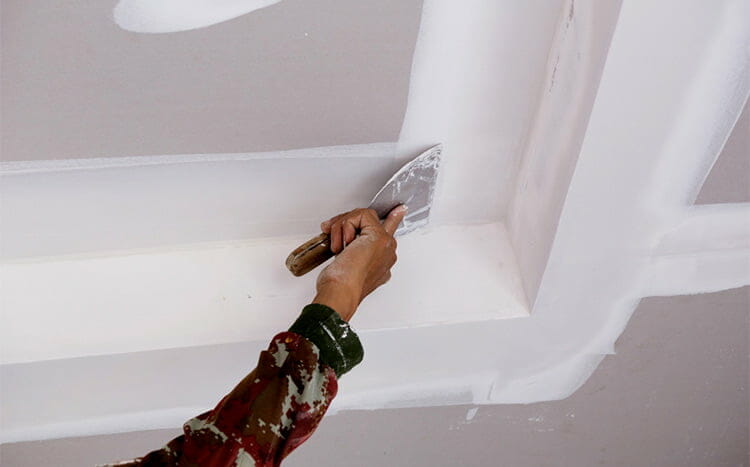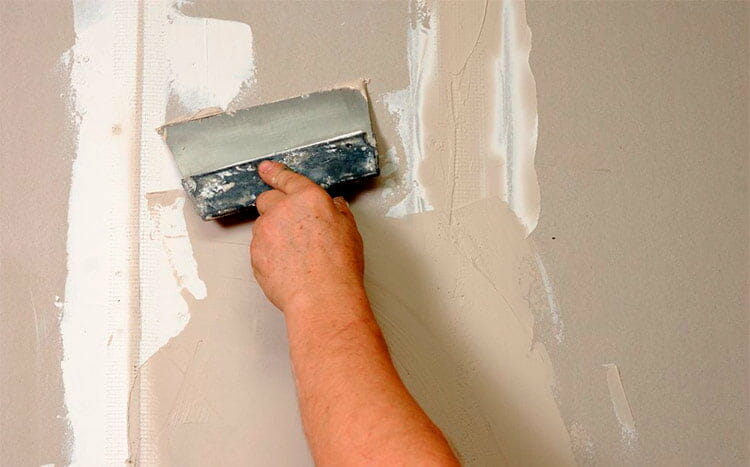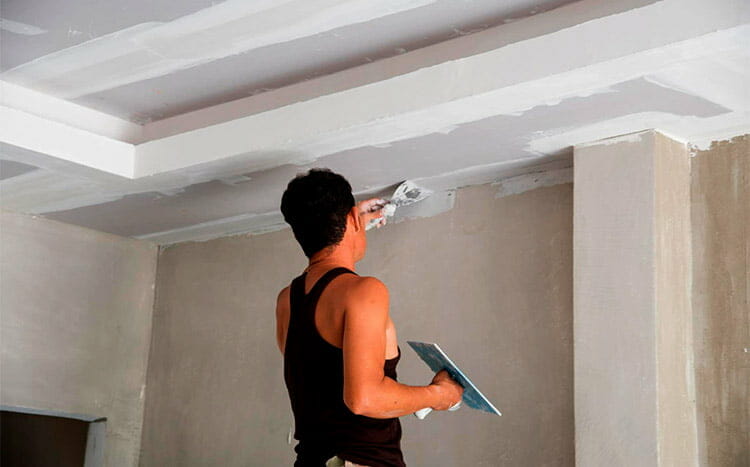When constructing a new residence or incorporating additional walls into your current dwelling, it’s essential to examine the options accessible for finishing the walls. Two potential choices to think about are plaster and drywall. Your ultimate choice will hinge on your individual taste and financial plan.
Drywall is designed using a gypsum board sandwiched between two thick sheets of paper. It is available in different thicknesses and sizes, and there are different types designed for specific purposes/rooms. Plaster, on the other hand, is denser, costlier, and more labor-intensive than drywall.
Plaster involves installing laths to the house studs and then applying several coats of plaster. Before World War II, this method was popular, but drywall took over World War II because of a lack of enough labor.

What we cover
ToggleHow to tell the difference between plaster and drywall?
If you cannot tell the difference between drywall and plaster, push a pin or thumbtack into the wall in a hidden area to test how hard it is. Drywall is usually softer than plaster, and it will not crack when you push the pin into the wall.
Plaster is harder and denser than drywall. It will not take in the pin, and it may splinter. This little experiment will tell you whether the walls have plaster or drywall finish.
Plaster vs. Drywall Pros and Cost
Both drywall and plaster are excellent choices for homes, and you can choose the one that suits you the most. For a more cost-effective option, drywall is the way to go. However, if you are looking for a higher-end look and finish, plaster should be your ideal pick, but it is more expensive to install than drywall.
Both options have their advantages and disadvantages, and it is essential to know them before making your choice.
Plaster
Advantages
- It is harder and more durable than drywall, so it can last for centuries
- It easily matches with older plasterwork in older homes for a more even and neat finish
- Plaster provides better sound-proofing than drywall
- It is better looking compared to drywall.
- It expands slightly and does not create cracks on the surface
- It easily mixes with water, and applying/leveling it is not difficult.
- Plaster offers more appealing finishes than drywall.
- Plaster is mold/mildew resistant.
Disadvantages
- Plaster can create echoes
- It is more costly and labor-intensive
- It is more difficult for DIY projects
- Repairing plaster can be challenging, especially if the area is large
- It is difficult to hang items on plaster walls.
Drywall
Advantages
- Drywall installation is faster and you can DIY smaller projects as long as you have basic knowledge
- Drywall repair is simple and straightforward
- Installing drywall is cheaper than plaster, and you can cut on the cost by hiring a handyman
- It has better insulation than plaster
- Drywall is available in a variety of options, including moisture and fire-resistant
- Hanging items on drywall is much easier.
Disadvantages
- Drywall is heavy, and moving it is quite challenging
- Bending drywall is difficult, which means it is not flexible.
- The finishes on drywall will not be as appealing as those of plaster
- It is not as durable as plaster
- Drywall is more prone to dents
Whether you are building a new home or remodeling your walls, both drywall and plaster can make good options. However, if you have curved surfaces, the plaster will be ideal because drywall is not flexible and does not bend. If you want to repair walls with existing plaster walls, the plaster will be a perfect choice.
For a more cost-effective solution, drywall will work just fine as long as you find an experienced drywall contractor to do the installation for you.
Plaster Vs Drywall cost comparison
The table below provides a summary of drywall and plaster costs. Check it out and compare the prices before you select the best option for your home.
| Material | Quantity | Low | High |
|---|---|---|---|
| Drywall cost | Per sq. foot | $1 | $3 |
| Plaster cost | Per sq. foot | $2 | $10 |
| Drywall cost per room | 10 x 12 room | $120 | $360 |
| Plaster Cost per room | 10 x 12 room | $1000 | $5000 |
| Drywall ceiling avg. cost | 10 x 12 room | $50 | $75 |
| Plaster ceiling avg. cost | 10 x 12 room | $200 | $400 |
The average cost to install plaster per square foot is approximately $2 to $10. If you want to resurface, expect to pay nothing less than $10 per square foot. If there is no resurfacing work, the cost is about $2 to $5 for the work. If your walls are high, you can pay an additional $0.40 to $2 per square foot for the job.
For a typical 100 square feet, you can pay about $510 on average with a low cost of $200 and a high cost of $1,200.
For drywall, the average cost of finishing drywall is about $1 to $3 per square foot. The entire project’s cost is approximately $1,842 on average, with a range of $1,020 and $2,876. The overall cost depends on the room’s size, level of finish, and complexity of the job.
Plastering walls is more expensive because it requires more expertise and takes more time than drywall. If you plan to paint your new walls, you should know that you cannot use drywall paint on plaster walls because the surfaces are completely different.

History or plaster and drywall
Both drywall and plaster have an interesting history. As mentioned above, both options have their advantages and disadvantages, and it is upon you to choose the best one for your home. Below is a brief history of these two wall finish options.
Drywall history
Drywall material was invented in the year 1916 by the US Gypsum Corporation. Fourteen years prior to inventing drywall, this company merged 30 different companies manufacturing gypsum and drywall. This company aimed at protecting US homes from urban fires and drywall was the best option for poor people and a cheaper alternative to plaster.
It took years before drywall became noticeable. In the 1940s, drywall sales grew by a huge percentage because of the baby boom. Over 21 million new homes were constructed between 1946 and 1960 because millions of new babies were born. This rapid rise in drywall purchase and use was because people wanted tidy and neat homes at a cheaper cost and put better meals on the table for their kids.
The USG is now the biggest of the eight drywall manufacturers in North America. This company holds about ¼ of the total gypsum industry market share. USG makes about $4 billion in sales annually and manufactures all types of wallboards.
Plaster history
The earliest form of plaster was lime-based and was developed around 7500 BC by the people of ‘Ain Ghazal, Jordan. These people mixed lime with unheated limestone, which was crushed to create plaster. The plaster created was used to cover walls, hearths, and floors. Most floors were decorated with red finger/hand-painted designs and patterns.
From around the 1700s to the 1940s, plaster was the choice for constructing interior walls. Contractors nailed lath (thin strips of wood) close together to wall studs then added several coats of plaster coats onto the lath to create flat wall surfaces.
Although drywall has taken over today, plaster is still reliable and more durable than drywall. It offers a better-looking finish and makes the space look much better.
Can you replace plaster with drywall?
Yes, you can replace plaster with drywall, but you must know the processes involved first. Although drywall is modern and readily available, the house may not feel the same. More so, space may be smaller, and the look of some of the adjacent details like moldings, windows, and door casings may be ruined.
Another area of concern is lead contamination. Older homes tend to be contaminated with lead, and it may poison you and your neighbors. For this reason, make sure you follow the right procedures and determine whether the ground around the building is contaminated by lead.
Most contractors charge approximately $1.020 to $2,800 for replacing plaster with drywall. This translates into $1.60 to $3.80 per square foot. This includes the demolition cost of $0.50 to $0.80 per square foot and the disposal cost of about $0.10 to $0.20 per square foot.
Can you use plaster on drywall?
Yes, you can apply plaster veneer on ordinary drywall. You will, however, need to glue the existing surface using a special adhesive compound before applying a thin layer of plaster. Once the walls have dried completely, you can decide to paint or install wallpaper.
FAQ's
Can you hang things on plaster walls?
Yes, you can hang things on plaster walls using screws. If the items are light, you can use a 1¼ – inch drywall screw to screw into the plaster wall and hang your items. It is best to use screws that have masonry anchors for heavier things as they will offer optimal support to your items.
Can you hang things on drywall?
Yes, you can hang items on drywall without a hassle. You can use screws for lighter items and drywall anchors for heavier ones. Drywall anchors go between the drywall and the screw and bite more effectively than screws. You can then screw into the drywall anchor to make sure everything stays stable.
Which is more sound-proof plaster or drywall?
When it comes to soundproofing, plaster is better than drywall. This is because it is dense and blocks any sound transmission better than drywall. Drywall, however, has better insulation than a plaster wall. When combined with modern insulation, plaster walls can offer better thermal capabilities than standard drywall.
Which looks better plaster or drywall?
Plaster usually has a higher-end look than drywall. Drywall is commonly used for most residential and commercial buildings, but plaster offers more high-end aesthetic upgrades. It is hand applied by highly skilled artisans, which gives it a higher quality than drywall.
Plaster can beat drywall in several areas. For instance, it provides better insulation when combined with modern insulation. It is also mold-resistant because mold and mildew cannot grow in it.














